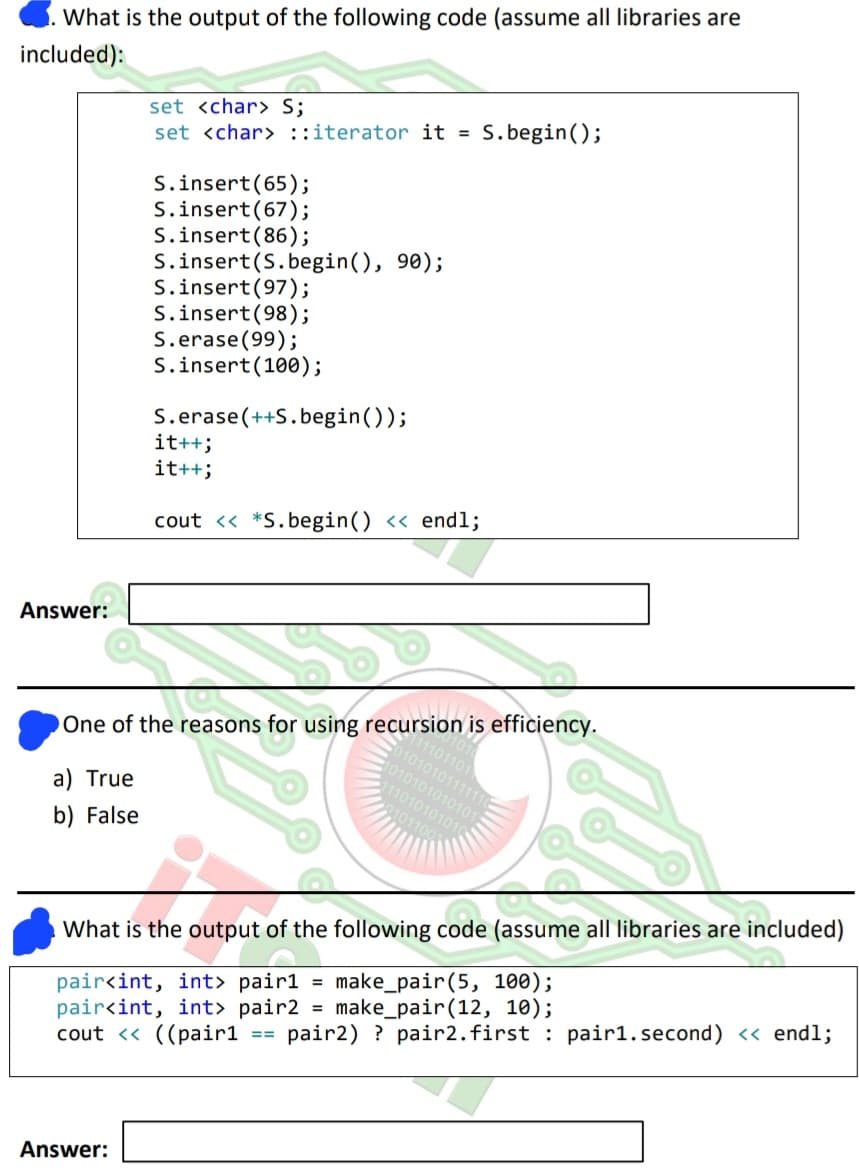. What is the output of the following code (assume all libraries are included): Answer: a) True b) False set S; set ::iterator it = S.begin(); Answer: S.insert (65); S.insert (67); S.insert (86); S.insert (S.begin(), 90); S.insert (97); S.insert (98); S.erase (99); S.insert (100); S.erase(++S.begin()); it++; it++; cout << *S.begin() << endl; 1101101 0101010111111 1010101010101 11101010101 101100 One of the reasons for using recursion is efficiency. What is the output of the following code (assume all libraries are included) pair pair1 = make_pair(5, 100); pair pair2 make_pair (12, 10); cout << ((pair1 == pair2) ? pair2. first pair1.second) << endl;
. What is the output of the following code (assume all libraries are included): Answer: a) True b) False set S; set ::iterator it = S.begin(); Answer: S.insert (65); S.insert (67); S.insert (86); S.insert (S.begin(), 90); S.insert (97); S.insert (98); S.erase (99); S.insert (100); S.erase(++S.begin()); it++; it++; cout << *S.begin() << endl; 1101101 0101010111111 1010101010101 11101010101 101100 One of the reasons for using recursion is efficiency. What is the output of the following code (assume all libraries are included) pair pair1 = make_pair(5, 100); pair pair2 make_pair (12, 10); cout << ((pair1 == pair2) ? pair2. first pair1.second) << endl;
Database System Concepts
7th Edition
ISBN:9780078022159
Author:Abraham Silberschatz Professor, Henry F. Korth, S. Sudarshan
Publisher:Abraham Silberschatz Professor, Henry F. Korth, S. Sudarshan
Chapter1: Introduction
Section: Chapter Questions
Problem 1PE
Related questions
Question

Transcribed Image Text:What is the output of the following code (assume all libraries are
included):
Answer:
a) True
b) False
set <char> S;
set <char> ::iterator it = S.begin();
S.insert (65);
S.insert (67);
S.insert (86);
Answer:
S.insert (S.begin(), 90);
S.insert (97);
S.insert (98);
S.erase (99);
S.insert (100);
S.erase(++S.begin());
One of the reasons for using recursion is efficiency.
it++;
it++;
cout << *S.begin() << endl;
1101101
01010101111
1010101010101
111010101010
101100
What is the output of the following code (assume all libraries are included)
=
pair<int, int> pair1 make_pair (5, 100);
pair<int, int> pair2 = make_pair (12, 10);
cout << ((pair1
==
pair2) ? pair2. first pair1.second) << endl;
Expert Solution
This question has been solved!
Explore an expertly crafted, step-by-step solution for a thorough understanding of key concepts.
Step by step
Solved in 4 steps

Knowledge Booster
Learn more about
Need a deep-dive on the concept behind this application? Look no further. Learn more about this topic, computer-science and related others by exploring similar questions and additional content below.Recommended textbooks for you

Database System Concepts
Computer Science
ISBN:
9780078022159
Author:
Abraham Silberschatz Professor, Henry F. Korth, S. Sudarshan
Publisher:
McGraw-Hill Education

Starting Out with Python (4th Edition)
Computer Science
ISBN:
9780134444321
Author:
Tony Gaddis
Publisher:
PEARSON

Digital Fundamentals (11th Edition)
Computer Science
ISBN:
9780132737968
Author:
Thomas L. Floyd
Publisher:
PEARSON

Database System Concepts
Computer Science
ISBN:
9780078022159
Author:
Abraham Silberschatz Professor, Henry F. Korth, S. Sudarshan
Publisher:
McGraw-Hill Education

Starting Out with Python (4th Edition)
Computer Science
ISBN:
9780134444321
Author:
Tony Gaddis
Publisher:
PEARSON

Digital Fundamentals (11th Edition)
Computer Science
ISBN:
9780132737968
Author:
Thomas L. Floyd
Publisher:
PEARSON

C How to Program (8th Edition)
Computer Science
ISBN:
9780133976892
Author:
Paul J. Deitel, Harvey Deitel
Publisher:
PEARSON

Database Systems: Design, Implementation, & Manag…
Computer Science
ISBN:
9781337627900
Author:
Carlos Coronel, Steven Morris
Publisher:
Cengage Learning

Programmable Logic Controllers
Computer Science
ISBN:
9780073373843
Author:
Frank D. Petruzella
Publisher:
McGraw-Hill Education